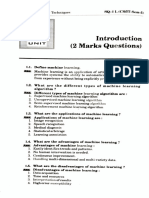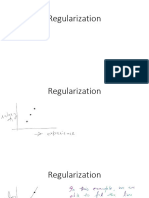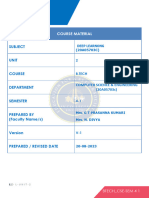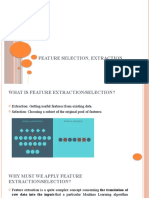0% found this document useful (0 votes)
91 views3 pagesMachine Learning Answers
The document contains answers to a Machine Learning mid-semester exam, covering topics such as supervised and unsupervised learning, reinforcement learning, overfitting, feature impact, regression vs classification, classification algorithms, k-Nearest Neighbors, and data preprocessing. Key concepts include the importance of labeled data in supervised learning, the role of features in model performance, and the steps involved in data preprocessing. The document also discusses advantages and disadvantages of various algorithms and techniques.
Uploaded by
nssaini1712Copyright
© © All Rights Reserved
We take content rights seriously. If you suspect this is your content, claim it here.
Available Formats
Download as DOCX, PDF, TXT or read online on Scribd
0% found this document useful (0 votes)
91 views3 pagesMachine Learning Answers
The document contains answers to a Machine Learning mid-semester exam, covering topics such as supervised and unsupervised learning, reinforcement learning, overfitting, feature impact, regression vs classification, classification algorithms, k-Nearest Neighbors, and data preprocessing. Key concepts include the importance of labeled data in supervised learning, the role of features in model performance, and the steps involved in data preprocessing. The document also discusses advantages and disadvantages of various algorithms and techniques.
Uploaded by
nssaini1712Copyright
© © All Rights Reserved
We take content rights seriously. If you suspect this is your content, claim it here.
Available Formats
Download as DOCX, PDF, TXT or read online on Scribd
/ 3





























































































